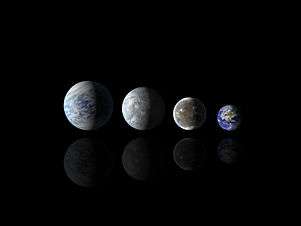GRB 130427A
.jpg) | |
| Other designations | GRB 130427A |
|---|---|
| Event type | gamma-ray burst |
| Detection | |
| Date | 27 April 2013 |
| Location | |
| Constellation | Leo |
| Energetics | |
| See also | |
|
| |
GRB 130427A was a record-setting gamma-ray burst, discovered starting on April 27, 2013.[1][2][3] This GRB was associated to SN 2013cq, of which the appearance of optical signal was predicted on May 2, 2013[4] and detected on May 13, 2013.[5][6] The Fermi space observatory detected a gamma-ray with an energy of at least 94 billion electron volts.[1] It was simultaneously detected by the Burst Alert Telescope aboard the Swift telescope and was one of the brightest bursts Swift had ever detected.[1] It was one of the five closest GRBs, at about 3.6 billion light-years away, and was comparatively long-lasting.[1]
Fermi's Large Area Telescope (LAT) recorded one gamma ray with an energy of at least 94 billion electron volts (GeV), or some 35 billion times the energy of visible light, and about three times greater than the LAT's previous record. The GeV emission from the burst lasted for hours, and it remained detectable by the LAT for the better part of a day, setting a new record for the longest gamma-ray emission from a GRB.— NASA[1]
Swift space observatory also observed the burst, quickly determining its location.[1] The X-ray afterglow of the burst was so bright that Swift was able to observe it for the next six months.
The emission was also detected using radio, infrared and visible radiation from ground based telescopes using the sky location from Swift.[7] The burst was observed with a 350mm optical telescope and its brightness measured. The visible apparent magnitude decreased from 13 to 15.5 over a three-hour period starting at 08:05:12 UTC 27 April 2013.[8] The Catalina Real-time Transient Survey also detected the burst optically, independent of the alert. It received designation CSS130502:113233+274156. It was found at right ascension 11:32:32.90, and declination +27:41:56.5 (J2000).[9] The SDSS catalogue shows a galaxy (SDSS J113232.84+274155.4) almost coincident with this position[10] at magnitude r=21.26 but with no SDSS spectrum obtained.
References
| Wikimedia Commons has media related to GRB 130427A. |
- 1 2 3 4 5 6 ASA's Fermi, Swift See 'Shockingly Bright' Burst 05.03.13
- ↑ Staff (21 November 2013). "NASA Sees 'Watershed' Cosmic Blast in Unique Detail". NASA. Retrieved 21 November 2013.
- ↑ Borenstein, Seth (21 November 2013). "'Monster' cosmic blast zipped harmlessly by Earth". AP News. Retrieved 21 November 2013.
- ↑ "GRB 130427A: Predictions about the occurrence of a supernova". 2 May 2013.
- ↑ "GRB 130427A: Spectroscopic detection of the SN from the 10.4m GTC". 13 May 2013.
- ↑ "GRB 130427A: GRB 130427A: Skynet detections of a possible supernova". 13 May 2013.
- ↑ "Fermi and Swift see 'shockingly bright' burst". 3 May 2013. Retrieved 5 May 2013.
- ↑ Wiggins, Patrick (28 April 2013). "GRB 130427A optical time series". GCN Circular 14490. NASA. Retrieved 5 May 2013.
- ↑ Drake, Andrew J.; Djorgovski, S. G.; Mahabal, A. A.; Graham, M. J.; Williams, R.; Prieto, J.; Catelan, M.; Christensen, E.; Larson, S. M. (4 May 2013). "An untriggered optical detection of GRB 130427A". The Astronomer's Telegram. Retrieved 5 May 2013.
- ↑ "SDSS DR8 Sky Server for the position of the GRB". Retrieved 7 May 2013.


